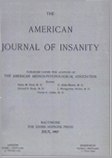HOSPITAL TREATMENT OF PATIENTS WITH PSYCHONEUROTIC DISORDERS
Abstract
1. A study of 100 psychoneurotic men patients admitted to the New York Hospital, Westchester Division, between 1927 and 1937 has been made.
2. Review of the family background revealed that these individuals predominantly came from close-knit, small families, where the father was a weak individual and the mother was aggressive and dominated the home. (Father was weak in 64 cases, mother aggressive and dominating in 67 cases.)
3. An analysis of the life histories revealed a high incidence of serious and prolonged physical illness in infancy and that this was one factor in fixing attention on the body in later life. Such patients responded unfavorably as a group to treatment.
4. The study of the present illness revealed that psychoneuroses tend to be of long duration before hospital treatment is instituted.
5. Identification with relatives suffering from serious physical or mental illness was an etiological factor in the illness of one-fourth of the patients.
6. Outstanding mental symptoms in their order of frequency were tenseness, depression, anxiety, sexual preoccupation, hypochondriasis, obsessions and compulsions, fear of insanity, and weakness. Patients with depression and anxiety as outstanding symptoms responded best to treatment, while fewer recoveries were found in the group displaying hypochondriasis, weakness or fear of insanity, than in the total group. The compulsive and obsessive patients responded least well to treatment.
7. The value of a full and varied program of activities supervised by the physicians and fitted to the patients' needs and capacities, together with frequent psychotherapeutic interviews, was substantiated by this study.
8. The average length of hospitalization was eight and a half months.
9. Follow-up studies of 100 men with psychoneurotic disorders, 4 to 14 years after discharge, revealed that 46 patients were then recovered, 5 much improved, 17 improved, making a total of 68 who had benefited by treatment.
Access content
To read the fulltext, please use one of the options below to sign in or purchase access.- Personal login
- Institutional Login
- Sign in via OpenAthens
- Register for access
-
Please login/register if you wish to pair your device and check access availability.
Not a subscriber?
PsychiatryOnline subscription options offer access to the DSM-5 library, books, journals, CME, and patient resources. This all-in-one virtual library provides psychiatrists and mental health professionals with key resources for diagnosis, treatment, research, and professional development.
Need more help? PsychiatryOnline Customer Service may be reached by emailing [email protected] or by calling 800-368-5777 (in the U.S.) or 703-907-7322 (outside the U.S.).



